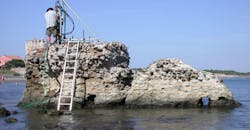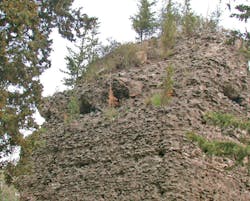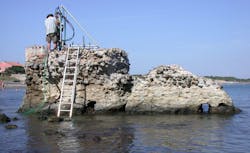It’s absolutely amazing that some of ancient Rome’s monuments have survived over the millennia—certainly so, when you view them with 21st-Century eyes. Romans living 2,000 years ago would have probably looked at them the same way we gaze upon modern structures such as the Empire State Building or the Hoover Dam: “Great architecture, but when you’ve seen one skyscraper or dam, you’ve seen them all.”
Still, this begs the question of why those ancient structures are still standing (even those found in water, such as piers). Most were made of stone and concrete and stood the test of time, yet my newly poured driveway is sure to crack and crumble in just several years, requiring maintenance. Even with modern machinery and materials, we haven’t been able to produce cement that could rival ancient Rome—that is, until now. Scientists have finally discovered the elements needed for what they call “the most durable material in history.”
It’s important to note that the typical cement used today for construction is known as Portland cement, a (caustic) hydraulic-based conglomerate that uses clinkers of pulverized calcium silicates that harden over time under a chemical reaction when water is introduced. This type of cement isn’t dissimilar from what the ancient Romans were producing; they just used different ingredients, primarily volcanic ash.
By comparison, today’s cement used in maritime construction will corrode over a short amount of time due to the salinity of seawater. Think of Hurricane Katrina and Louisiana’s levee systems, and you get the idea. However, by taking a page from the Roman’s recipe book, we could protect those living on coastlines as the shores continue to recede from global warming without worry of corrosion and material failure.
To figure out why the cement was so durable, scientists took core samples from sites all over Italy, studied ancient writings on Roman sea structures, and found that the material undergoes a rare chemical reaction when submerged in water. The cement itself is comprised of quicklime (calcium oxide) and the aforementioned volcanic ash. That ash is the key—the secret ingredient that makes their concrete super-strong and incredibly durable.
When the ash comes in contact with liquid and seeps into its cracks, it undergoes a chemical reaction and forms specific minerals: Al-tobermorite and phillipsite. Both of these strengthen the cement as they grow. In fact, the cement continues to grow stronger even today.
There does exist one small problem with producing the cement used by the Romans in a modern setting. Nobody knows exactly how to make it! Even with the samples and texts, the complete formula is missing. However, geologist Marie Jackson from the University of Utah and a team of researchers are looking to recreate it, utilizing volcanic ash found in the Pacific Ocean off the coast of San Francisco.
“Romans were fortunate in the type of rock they had to work with,” Jackson noted in a press release. “They observed that volcanic ash grew cement to produce the stuff. We don’t have those rocks in a lot of the world so there would have to be substitutions made.”
Another issue with trying to produce the cement is that it requires the same ash material used by the Romans, which is only in a very limited supply and located only in certain areas around Italy. Jackson notes that although you can technically synthesize it in a lab, it takes a tremendous amount of heat and energy just to produce it on a small scale—something Mother Nature does extremely well.
It should also be noted that it takes time for Roman cement to gain its strength from sea water and doesn’t feature the same compression strength as Portland cement, which would limit the widespread use of the material. On the other hand, it would still be a viable solution for smaller-scale projects such as levees, tidal lagoons to harness ocean/lake energy, and even aqueducts for coastal cities. If Jackson and her team can utilize alternative materials to produce their cement, we could see the implications sometime in the near future.
About the Author
Cabe Atwell
Engineer, Machinist, Maker, Writer. A graduate Electrical Engineer actively plying his expertise in the industry and at his company, Gunhead. When not designing/building, he creates a steady torrent of projects and content in the media world. Many of his projects and articles are online at element14 & SolidSmack, industry-focused work at EETimes & EDN, and offbeat articles at Make Magazine. Currently, you can find him hosting webinars and contributing to Penton’s Electronic Design and Machine Design.





